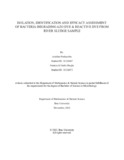Isolation, identification and efficacy assessment of bacteria degrading azo dye & reactive dye from river sludge sample
Abstract
Textile and dyeing industry’s effluents and wastes are considered one of the top water pollutants
in Bangladesh which ultimately leads to public health hazard. This study intends to explore the
capacity of local bacteria to degrade dye and the roles of pH concentration and temperature in
facilitating Azo dye and Reactive Dye degradation. Samples from river sludge were taken from
the Dhaleshwari and Turag rivers and serially diluted. Then bacterial isolation was randomly
selected based on morphology and each individual colony of focus was inoculated in dye-mixed
nutritional broth. Colonies were cultured for seven days at various temperatures and had different
pH concentrations to study biodegradability. To determine the actual decolourizationn (%)
amount, optical density values were measured for each sample in the meanwhile. All
microorganisms demonstrated successful biodegradability for selected dyes. Biochemical tests
were carried out for the identification of the bacterial strains. This study found that Bacillus spp.
degraded azo dye at a rate of 69.26% at pH 6 & 37 ̊c. Furthermore, Bacillus spp. Attained 52.70
% degradation at pH 6 and 45 °c. The results disclosed that Bacillus spp. were the most efficient
in degrading reactive and azo dyes, followed by Bacillus subtilis and Staphylococcus hominis.
This study can further instigate the scope of the biodegradability of dye to be ready for
commercial usage for effluent treatment.

